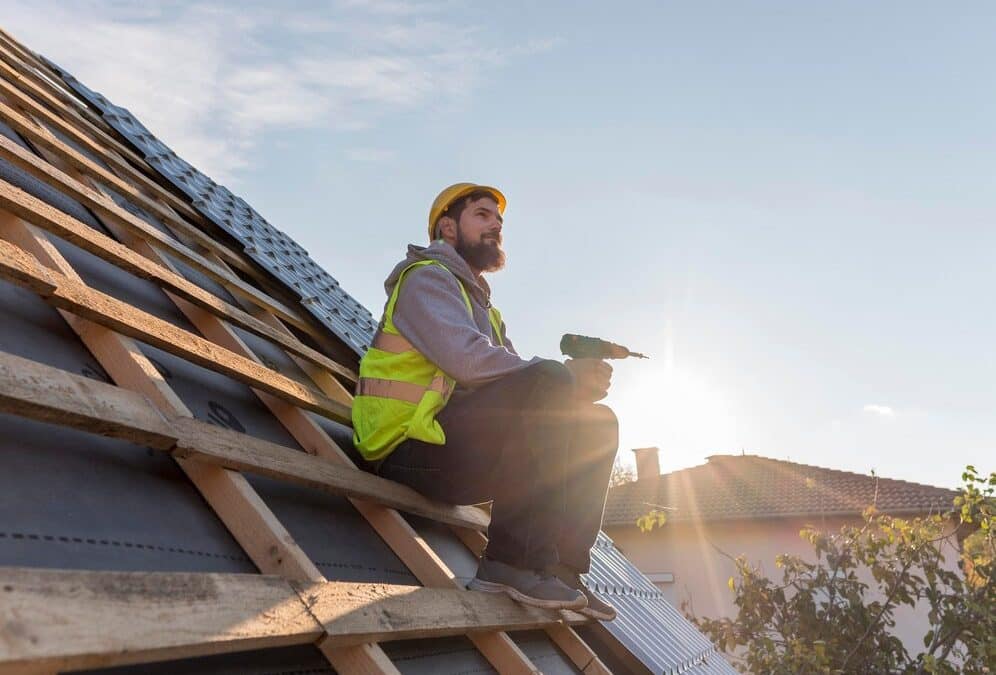Winter can be rough on your roof. Snow, ice, and cold temperatures cause damage that needs attention to keep your roof in good shape. After the snow melts, it’s important to inspect your roof for any issues that could lead to bigger problems if left untreated.
Identifying and repairing winter roof damage early can save you a lot of money and hassle. Damaged shingles, leaks, and other issues can worsen if ignored. By being proactive, you make sure your roof stays strong and your home remains protected.
In this article, we’ll cover common types of winter roof damage and provide steps to repair them. You’ll learn what tools and materials you need and find helpful tips to prevent future problems. Taking care of your roof now ensures it lasts longer and does its job well.
Identifying Common Types of Winter Roof Damage
Winter weather can lead to different types of damage on your roof. Knowing what to look for helps you identify problems early and take action.
1. Ice Dams: Ice dams form when melting snow refreezes at the edge of your roof. This blocks water from draining properly, causing leaks and damage to shingles.
2. Damaged Shingles: Strong winds and the freeze-thaw cycle can crack or lift shingles. Cracked shingles allow water to seep in, which can lead to leaks and rot.
3. Clogged Gutters: Debris and ice in gutters stop water from flowing off the roof. Water can back up and cause leaks or even damage the roof structure.
4. Snow Load: Heavy snow adds extra weight to your roof, potentially causing it to sag or even collapse if the weight is too much for the structure.
5. Leaks and Water Stains: Melting snow can find its way into small cracks and holes, causing leaks and water stains inside your home.
Recognizing these common issues helps you take the first step toward repairing and protecting your roof. Regular checks after winter ensure your roof stays in good condition.
Essential Tools and Materials for Roof Repairs
Having the right tools and materials makes roof repairs easier and more effective. Here’s what you’ll need:
1. Ladder: Ensure your ladder is sturdy and can reach your roof safely.
2. Roofing Nails and Hammer: These secure shingles and other materials.
3. Roofing Cement: Use this to seal cracks, holes, and joints.
4. Shingles: Keep extra shingles that match your roof handy for replacements.
5. Utility Knife: A sharp knife is useful for cutting shingles and other materials.
6. Safety Gear: Wear gloves, safety glasses, and a harness for protection.
7. Measuring Tape: Accurate measurements help ensure materials fit correctly.
8. Sealant: This is crucial for making sure small gaps and cracks are sealed tight.
9. Caulking Gun: Use this tool to apply roofing cement and sealant.
Having these tools and materials ready ensures you can tackle most basic roof repairs. Proper preparation helps you fix issues efficiently and maintain a durable roof.
Step-by-Step Guide to Fixing Winter Roof Damage
Fixing winter roof damage promptly ensures your roof remains strong and functional. Follow these steps to tackle common repairs:
1. Inspect the Roof: Start by carefully inspecting your roof. Look for broken shingles, ice dams, and other signs of damage. Use the checklist from the essential tools section to ensure you have everything you need.
2. Replace Missing or Damaged Shingles: Use a utility knife to remove damaged shingles. Slide the new shingles in place and secure them with roofing nails. Apply roofing cement to seal the edges and prevent water seepage.
3. Remove Ice Dams: Carefully remove any remaining ice dams using a roof rake or other tools designed for the job. Never use sharp tools that can damage the shingles.
4. Seal Cracks and Holes: Use roofing cement and a caulking gun to seal any visible cracks, holes, or gaps. Ensure the roof is dry before application for the best results.
5. Clear and Repair Gutters: Remove any debris from gutters to ensure proper drainage. Check for sections that may be loose or damaged and fix them with screws or gutter sealant.
6. Inspect Flashing: Check the flashing around chimneys, vents, and other areas for damage. Replace or repair any faulty flashing to keep water out.
7. Check Attic for Leaks: After making repairs, check your attic for signs of leaks or water damage. This acts as a further check on your repair work.
A methodical approach to repairs ensures you address all issues and maintain the integrity of your roof. Take your time to make sure each step is done correctly.
Preventative Measures to Protect Your Roof in the Future
Preventing roof damage is easier and less costly than making repairs. Implement these measures to extend your roof’s lifespan and avoid winter damage:
1. Seasonal Inspections: Regularly inspect your roof in the spring and fall. This helps you catch and address minor issues before they become major problems.
2. Proper Insulation: Ensure your attic is well-insulated to maintain a consistent roof temperature. This helps prevent ice dams from forming.
3. Ventilation: Make sure your attic has proper ventilation. Good airflow reduces moisture buildup and prevents mold, rot, and ice dams.
4. Gutter Maintenance: Keep your gutters clean and free from debris. Gutter guards can help keep leaves and twigs out, ensuring water flows smoothly off your roof.
5. Trim Overhanging Branches: Trees close to your roof can drop branches and leaves, causing damage or clogs. Trimming these branches back helps protect your roof.
6. Install a Snow Guard: A snow guard helps manage the snow load on your roof. This prevents heavy snow from accumulating and causing stress on your roof structure.
Implementing these preventative measures ensures your roof remains in good condition and better withstands harsh winter conditions.
Conclusion
Taking care of winter roof damage is essential for maintaining a safe and durable home. By identifying common types of damage, using the right tools, following a step-by-step repair guide, and implementing preventative measures, you ensure your roof lasts longer and performs better. Regular maintenance and timely repairs save money and prevent bigger problems down the road.
If you’re unsure about the extent of your roof damage or need professional roofing services, contact Mike Huddleston Roofing Systems. Our expert team can help assess and repair your roof, ensuring it is ready to face any weather. Call us today to schedule your inspection and keep your home safe and protected.

